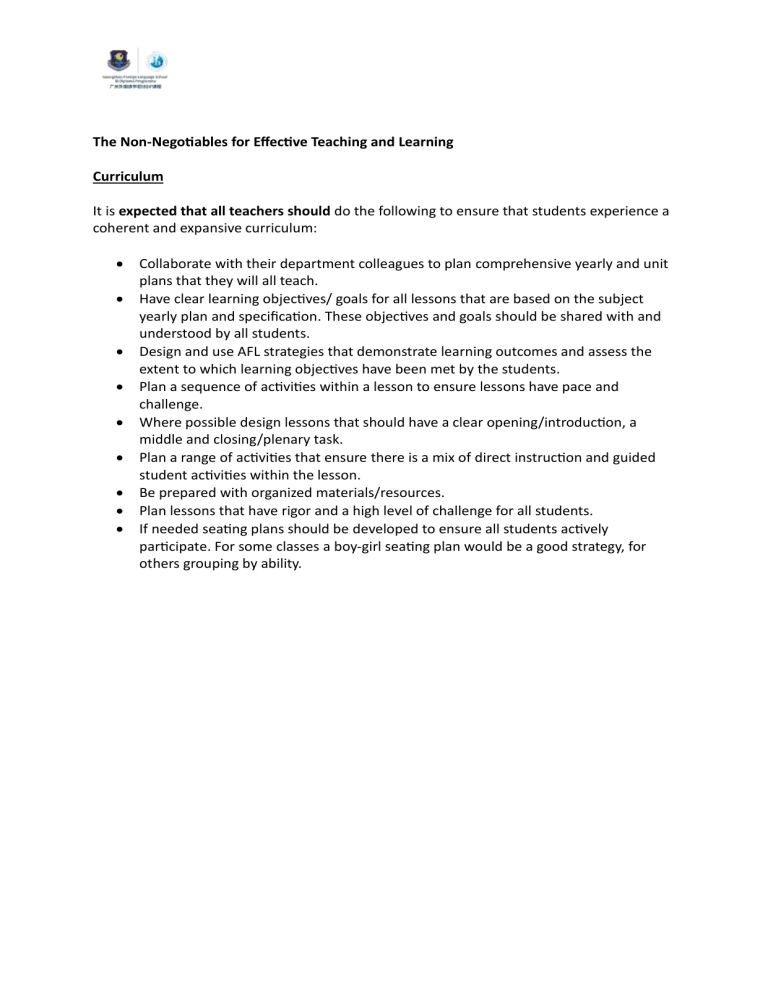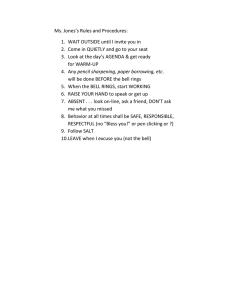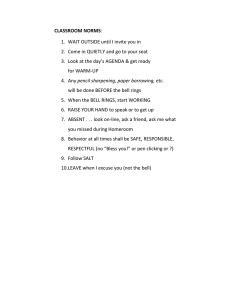
The Non-Negotiables for Effective Teaching and Learning Curriculum It is expected that all teachers should do the following to ensure that students experience a coherent and expansive curriculum: Collaborate with their department colleagues to plan comprehensive yearly and unit plans that they will all teach. Have clear learning objectives/ goals for all lessons that are based on the subject yearly plan and specification. These objectives and goals should be shared with and understood by all students. Design and use AFL strategies that demonstrate learning outcomes and assess the extent to which learning objectives have been met by the students. Plan a sequence of activities within a lesson to ensure lessons have pace and challenge. Where possible design lessons that should have a clear opening/introduction, a middle and closing/plenary task. Plan a range of activities that ensure there is a mix of direct instruction and guided student activities within the lesson. Be prepared with organized materials/resources. Plan lessons that have rigor and a high level of challenge for all students. If needed seating plans should be developed to ensure all students actively participate. For some classes a boy-girl seating plan would be a good strategy, for others grouping by ability. Instruction In all lessons teachers should demonstrate the following: The language of instruction for most of the lesson is the same as the language the students’ assessment will be in. Overt teaching of metalanguage and vocab, for example key tier 2 and 3 key words should be used in the lesson, contained in key word lists, and displayed on the board. A variety of instruction and tasks; direct instruction, directed collaborative tasks and independent tasks have been planned. That they have checked for understanding before, during and after a task. This is sometimes known as chunking and checking, so tasks and assessments are broken down into smaller steps. That they have given clear and explicit instructions so students can follow their directions to complete tasks successfully. They have planned for effective use of technology. If the teacher is using direct instruction, then all students should have their laptops closed. If laptops are being used for a lesson, then it needs to be planned and guided, it is unacceptable to just direct a student to, “Do some research.” Assessment All teachers should demonstrate a good understanding of their students by using a range of assessment activities, including but not limited to: Varied questioning then addresses misconceptions or develops students’ understanding further. Chunking and checking. AFL during the lesson, including exit tickets and closing the loop activities. Effective use of the students’ notebooks is evidenced by teacher marking, student self-assessment and reflection (purple pens) and peer assessment. One summative authentic assessment task that connects to the assessment criteria given in the specification. Where there is more than one teacher in the year group or course these summative assesssments must be aligned. Routines Studies show that students thrive on routines and that it leads to effective learning so each lesson teachers must: Teach Bell to Bell. Instruction and learning should begin on the bell so teachers and students need to be in the classroom before the bell ready to begin learning and lessons should not end before the bell. Have their own established routines for an orderly start and finish to the lesson. This could include an entry or settling activity, asking students to stand behind their tables at the end of the lesson to check their desks are tidy. Ensure that students clean the classroom/take their materials at the end of the lesson. Wipe the board, rearrange desks if necessary, and leave the teacher areas tidy at the end of the lesson so that their colleagues can have a smooth start to class. Develop a routine for recording poor behaviour on managebac either during or after a lesson. Take attendance as directed by the pastoral team and any absences checked and HR teachers informed. Ensure students understand their laptop rules and regularly monitor students if they are using laptops.




